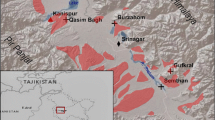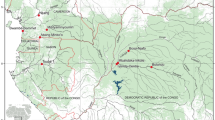Abstract
Heavy deposits of charcoal and associated Zea pollen recovered from the Aguada Petapilla in the Copán Valley of western Honduras strongly support Hugh lltis’s hypothesis concerning the early domestication and use of maize. Evidence of burning and cultivation appear at approximately 2600–2700 b.c., predating the earliest direct archaeological evidence for human occupation of the region by more than 1,000 years. These Copán data are in close agreement with two other sediment cores from Honduras, and also with maize macrofossils recently recovered from dry deposits in El Gigante Cave.
Similar content being viewed by others
Literature Cited
Abrams, E., and D. Rue. 1988. The causes and consequences of deforestation among the prehistoric Maya. Human Ecology 16:377–395.
Bellon, M., and S. Brush. 1994. Keepers of maize in Chiapas, Mexico. Economic Botany 48(2): 196–209.
Benz, B. 2001. Archaeological evidence of teosinte domestication from Gila Naquitz, Oaxaca. Proceedings of the National Academy of Science 98:2104–2106.
Curtis, J. H., M. Brenner, and D. Hodel. 2001. Climate change in the Circum-Caribbean (Late Pleistocene to present) and implications for regional biogeography. Pages 35–54 in C. A. Woods and F. E. Sergile, eds., Biogeography of the West Indies, CRC Press, Boca Raton.
Deevey, E. S., and M. Stiuver. 1964. Distribution of natural isotopes of carbon in Lindley Pond and other New England lakes. Limnology and Oceanography 9:1–11.
Fash, William L. Jr. 1991. Scribes, warriors, and kings. Thames and Hudson, Inc., New York.
Fisher, C. T., H. Pollard, I. Israde-Alcantara, V. Garduno-Monroy, and S. Bannerje. 2003. A reexamination of human-induced environmental change within the Lake Patzcuaro Basin, Michoacan, Mexico. Proceedings of the National Academy of Sciences 100(8):4957–4962.
Hodell, D. A., J. H. Curtis, and M. Brenner. 1995. Possible role of climate in the collapse of Classic Maya civilization. Nature 375(1):391–357.
Horn, S. 1993. Postglacial vegetation and fire history in the Chirripó Paramó of Costa Rica. Quaternary Research 40:107–116.
—,and R. L. Sanford Jr. 1992. Holocene fires in Costa Rica. Biotropica 24(3):354–361.
—,and L. M. Kennedy. 2001. Pollen evidence of maize cultivation 2700 B.P at La Selva Biological Station, Costa Rica. Biotropica 33(1):191–196.
Iltis, H. 2000. Homeotic sexual translocations and the origins of maize (Zea mays, Poacaea): A new look at an old problem. Economic Botany 54(1):7–42.
-. 2004. Domestication of Zea: First for sugar and then for grain? A novel idea with vast implications. Paper presented at the 69th Annual Meeting of the Society for American Archaeology, Montreal.
Joyce, R., and J. S. Henderson. 2001. Beginnings of village life in eastern Mesoamerica. Latin American Antiquity 12(1):5–24.
Leyden, B. 2002. Pollen evidence for climatic variability and cultural disturbance in the Maya Low lands. Ancient Mesoamerica 13:85–101.
Matsuoka, Y., Y. Vigouroux, M.M. Goodman, J. Sanchez, G. E. Buckler, and J. Doebley. 2002. A single domestication for maize shown by multilocus micorsatellite genotyping. Proceedings of the National Academy of Sciences 99(9):6080–6084.
Newsom, L., and K. A. Deagan. 1994. Zea mays in the West Indies: The archaeological and early historical record. Pages 203–218 in S. Johannessen and C. Hasdorf, eds., Corn and culture in the Prehistoric New World. Westview Press, Boulder.
Piperno, D. R., and K. V. Flannery. 2001. The earliest archaeological maize (Zea mays) from highland Mexico: New accelerator mass spectrometry dates and their implications. Proceedings of the National Academy of Sciences 98:2101.
—,and M. W. Schwartz. 1990. Temperate hardwood forests. Pages 194–281 in R. L. Myers and J. J. Ewel, eds., Ecosystems of Florida. University of Central Florida Press, Orlando.
Pohl, M. E. D., K. O. Pope, J. G. Jones, J. Jacob, D. Piperno, S. deFrance, D. L. Lentz, J. Gifford, M. Danforth, and J. K. Josserand. 1996. Early agriculture in the Maya Lowlands. Latin American Antiquity 7(4):355–372.
Pope, M.,K. Pope,B. Benz,D. Lentz,J. Jones,D. Piperno,J. Iriarte,andI. Holst. 2004. Maize in southeastern Mesoamerica. Paper presented at the 69th Annual Meeting of the Society for American Archaeology, Montreal.
Pope, K. O., M. E. D. Pohl, J. G. Jones, D. L. Lentz, C.von Nagy, F. J. Varga, and I. R. Quitmyer. 2001. Origin and environmental settings of ancient agriculture in the lowlands of Mesoamerica. Science 292:1370–1373.
Reed, D. 1997. Ancient Maya diet at Copán: Insights from stable isotopes and porotic hyperostosis. Pages 157–170 in S. L. Whittington and D.M. Reed, eds. Bones of the Maya. Smithsonian Institution Press, Washington, D.C.
Rue, D. 1987. Agriculture and early postclassic Maya occupation in western Honduras. Nature 326:285–286.
—,D. Webster, and A. Traverse. 2002. Late Holocene fire and agriculture in the Copán Valley, Honduras. Ancient Mesoamerica 13:267–273.
Smalley, J., and M. Blake. 2003. Sweet beginnings. Current Anthropology 44:675–703.
Smith, B. D. 1995a. Origins of agriculture in the Americas. Evolutionary Anthropology 3(5):174–184.
—. 1995b. The emergence of agriculture. Scientific American Library, New York.
Stuiver, M., and P. J. Reimer. 1993. Radiocarbon calibration computer program. Radiocarbon 35: 215–2301.
Traverse, A. 1988. Paleopalynology. Unwin/Hyman Ltd., United Kingdom.
Webster, D. 2002. The fall of the Ancient Maya. Thames and Hudson Ltd., London.
—,A. Freter, and N. Gonlin. 2000. Copán: The rise and fall of an ancient Maya kingdom. Harcourt Brace, Fort Worth.
—,A. Freter, and S. Storey. 2004. Pages 231–259 in A. Demarest, P. Rice, and D. Rice, eds., Dating Copan culture-history: Implications for the Terminal Classic and the collapse. University of Colorado Press, Boulder.
Wingard, J. 1996. Interactions between demographic processes and soil resources in the Copán Valley, Honduras. Pages 207–235 in S. Fedick, ed., The managed mosaic: Ancient Maya agriculture and resource use. University of Utah Press, Salt Lake City.
Author information
Authors and Affiliations
Corresponding author
Rights and permissions
About this article
Cite this article
Webster, D., Rue, D. & Traverse, A. EarlyZea cultivation in Honduras: Implications for the iltis hypothesis. Econ Bot 59, 101–111 (2005). https://doi.org/10.1663/0013-0001(2005)059[0101:EZCIHI]2.0.CO;2
Received:
Accepted:
Issue Date:
DOI: https://doi.org/10.1663/0013-0001(2005)059[0101:EZCIHI]2.0.CO;2




